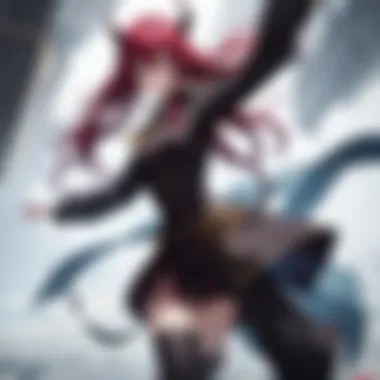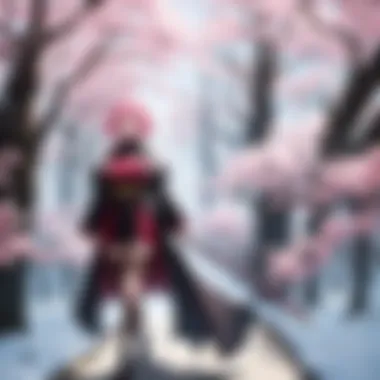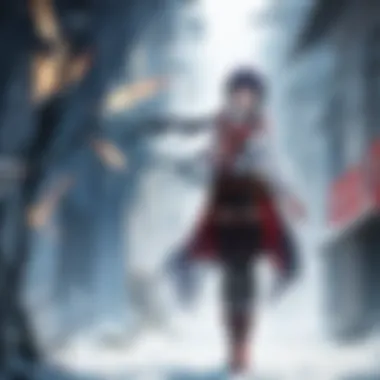Unveiling the Intricacies of the Demon Slayer Movie on Funimation: A Detailed Review


Anime Series Overview
The Demon Slayer movie available on Funimation stems from the immensely popular anime series that took the anime community by storm. With a riveting plotline filled with twists and turns, the series encapsulates themes of resilience, loss, and camaraderie. Viewers are introduced to a diverse set of characters, each embarking on a journey of self-discovery and growth amidst adversity. The animation style is noteworthy for its attention to detail, vibrant colors, and fluid motion, while the soundtrack heightens emotional moments and action sequences. Notable episodes showcase the series' ability to balance intense combat scenes with poignant character interactions.
Character Analysis
Taking a closer look at the main characters of Demon Slayer reveals a tapestry of personalities and motivations. Protagonist Tanjiro exudes empathy and determination, driven by his quest for justice and redemption. His companions, such as Nezuko and Zenitsu, bring their own complexities to the table, showcasing themes of loyalty and resilience. The relationships between characters evolve organically, from initial skepticism to deep bonds forged through shared experiences. Fan theories abound regarding hidden depths and potential character arcs, adding to the intrigue surrounding the series.
Genre Spotlight
Within the realm of anime, Demon Slayer represents the shonen genre, known for its focus on action, friendship, and personal growth. This genre has a rich history in the anime industry, with iconic series like Naruto and Dragon Ball setting the standard for exciting battles and character development. Demon Slayer distinguishes itself through its unique blend of traditional elements and modern storytelling, appealing to both seasoned anime fans and newcomers alike. By exploring the genre's evolution, viewers gain insight into the broader context of anime storytelling and thematic exploration.
Behind-the-Scenes Insights
Delving into the production of Demon Slayer offers a glimpse into the intricate process of bringing manga to life on screen. From initial concept design to the adaptation of key scenes, each step requires meticulous attention to detail and artistic vision. Challenges during production, such as meeting deadlines and maintaining quality, are common in the fast-paced world of animation. Success factors often stem from the collaborative efforts of animators, voice actors, and production staff, who work tirelessly to ensure the series resonates with audiences worldwide.
Introduction to Demon Slayer Movie
In this exhaustive analysis of the Demon Slayer Movie available on Funimation, we embark on a journey to unravel the intricate layers of this anime masterpiece. The importance of understanding the essence of the movie lies in its cultural impact and storytelling brilliance. By examining the various facets of the film, we aim to provide a holistic view for both devoted anime enthusiasts and newcomers to the genre.
Overview of the Movie
Synopsis of the Plot
Diving into the Synopsis of the Plot allows us to grasp the fundamental narrative structure that drives the movie forward. The storyline serves as a cornerstone of the entire viewing experience, setting the stage for character development and thematic exploration. Analyzing the plot in detail enables viewers to appreciate the complexities of the story and the emotional depth it brings. This section not only outlines the sequence of events but also delves into the underlying messages and themes portrayed throughout.
Background Setting
The Background Setting of the movie plays a pivotal role in creating the immersive world where the characters reside. It sets the tone for the entire narrative, painting a vivid picture of the environment and the challenges the characters face. By exploring the intricacies of the setting, we gain a deeper understanding of the context in which the story unfolds. The attention to detail in crafting the backdrop enhances the overall viewing experience, drawing viewers into a rich and compelling universe filled with both beauty and danger.
Character Analysis
Character analysis in this article plays a pivotal role in dissecting the core of each character's essence, motivations, and impact on the overarching narrative of the Demon Slayer movie. By scrutinizing the intricacies of each character's development and traits, readers gain a profound understanding of the psychological depth and thematic significance woven into the storyline. Character analysis provides a lens through which viewers can appreciate the complexities and nuances of Tanjiro Kamado, Nezuko Kamado, Zenitsu Agatsuma, and Inosuke Hashibira, shedding light on their roles as catalysts for the progression of events within the movie.


Main Characters
Tanjiro Kamado
Tanjiro Kamado embodies the epitome of resilience and compassion amidst adversity. His unwavering determination to protect his loved ones and seek justice for his family sets him apart as a protagonist driven by altruism and integrity. Tanjiro's profound sense of empathy and innate ability to perceive the innate goodness in others not only endears him to audiences but also reinforces the central themes of righteousness and empathy present throughout the movie. His journey from a grief-stricken brother to a stalwart demon slayer showcases the evolution of his character, making him a linchpin in the emotional core of the narrative.
Nezuko Kamado
Nezuko Kamado introduces a unique dichotomy through her portrayal as a demon with unwavering loyalty to her family. Her silent yet powerful presence adds a layer of complexity to the storyline, challenging conventional perceptions of good and evil. Nezuko's fierce protectiveness of her brother and her willingness to defy societal norms defy her seemingly monstrous nature, emphasizing the depth of familial bonds and the resilience of the human spirit. Her transformation throughout the movie exemplifies the triumph of love over darkness, making her a symbol of hope and redemption.
Zenitsu Agatsuma
Zenitsu Agatsuma's character arc revolves around his insecurities and self-doubt, setting him apart as a nuanced and relatable character grappling with inner turmoil. Despite his outward cowardice, Zenitsu's moments of bravery and selflessness showcase his hidden potential and unwavering loyalty to his friends. His comical yet profound development underscores themes of self-discovery and courage, serving as a testament to the transformative power of facing one's fears. Zenitsu's comic relief and heartfelt moments evince the multifaceted nature of his character, resonating with audiences on an emotional level.
Inosuke Hashibira
Inosuke Hashibira embodies raw strength and primal instinct, epitomizing the wild, untamed spirit within the demon slayer corps. His brash demeanor and penchant for recklessness add a dynamic energy to the group dynamic, challenging conventional norms with his unpredictable nature. Inosuke's growth from a solitary fighter to a trusted ally underscores the theme of camaraderie and acceptance, highlighting the importance of unity in the face of adversity. His unyielding resolve and unorthodox methods breathe vitality into the narrative, making him a formidable force to be reckoned with and a source of levity amidst the darkness.
Villains and Antagonists
Muzan Kibutsuji
Muzan Kibutsuji emerges as the enigmatic and formidable mastermind behind the demon hierarchy, wielding power and malevolence with chilling precision. His cunning intellect and ruthless nature pose a formidable challenge to the demon slayers, embodying the epitome of evil in its rawest form. Muzan's elusive nature and strategic prowess add a sense of foreboding to the narrative, underscoring the omnipresent threat lurking in the shadows. His enigmatic presence and sinister motivations drive the narrative forward, casting a long shadow over the protagonists and fueling the sense of urgency in their mission.
Lower Moons
The Lower Moons represent a tier of antagonists characterized by diverse abilities and allegiances within the demon ranks. Each Lower Moon introduces a distinct challenge for the demon slayers, showcasing a varied spectrum of powers and personalities. Their confrontations with the protagonists serve as pivotal moments of tension and conflict, testing the limits of the demon slayers' resolve and ingenuity. The Lower Moons' role in the overarching narrative highlights the ever-present threat of demonkind and the insidious nature of evil, adding layers of complexity to the central conflict.
Upper Moons
The Upper Moons stand as the pinnacle of demonic power and influence, representing the elite echelon of Muzan's loyal followers. Their formidable strength and strategic acumen pose the greatest threat to the demon slayers, pushing them to the brink of their abilities and convictions. The Upper Moons' intricate designs and abilities showcase the pinnacle of animation and creativity, immersing audiences in a world of danger and intrigue. Their cataclysmic clashes with the protagonists culminate in high-stakes battles that redefine the boundaries of the demon slaying profession, cementing their status as formidable adversaries and proponents of chaos within the narrative.
Animation and Visuals
Animation and visuals play a pivotal role in enhancing the viewer's experience of the Demon Slayer movie on Funimation. The seamless integration of animation and visual elements not only captivates the audience but also conveys emotions and intensifies storytelling. Through meticulous attention to detail and striking visuals, the movie creates an immersive world that resonates with the viewers, setting a high standard for animation quality and artistic expression.


Artistic Style
Detailed Animation
Detailed animation in the Demon Slayer movie is a hallmark of its visual brilliance. Every frame is intricately crafted to highlight subtle movements and expressions, elevating the overall viewing experience. The meticulous attention to detail in character design and background scenery brings the anime to life, immersing the audience in the vibrant world of Demon Slayer. This intricate animation style adds depth to character interactions, fight sequences, and emotional moments, enhancing the overall storytelling.
Combat Sequences
The combat sequences in the movie are adrenaline-fueled spectacles that showcase the skill and creativity of the animators. Each battle is choreographed with precision, blending fluid movements with strategic combat tactics. Through dynamic camera angles and seamless transitions, the combat sequences convey a sense of urgency and intensity that keeps viewers at the edge of their seats. The incorporation of special effects and dynamic action scenes adds a layer of excitement to the fights, making them visually stunning and memorable.
Visual Aesthetics
Visual aesthetics in the Demon Slayer movie are a visual feast for the eyes. The attention to color palettes, lighting effects, and scenery design creates a visually stunning world that immerses the audience in the rich tapestry of the story. The use of contrasting colors and intricate details enhances the mood and atmosphere of each scene, adding depth and complexity to the narrative. The visual aesthetics not only serve to complement the storytelling but also evoke emotions and heighten the overall viewing experience.
Impact of Animation on Storytelling
Animation plays a crucial role in storytelling, shaping the narrative and evoking emotional responses from the audience in the Demon Slayer movie. The impactful use of animation techniques enhances the depth of the story, making it more engaging and immersive for viewers. The seamless integration of animation with storytelling elements elevates the emotional resonance, symbolism, and world-building within the movie, creating a multi-dimensional experience for the audience.
Emotional Resonance
Emotional resonance in the animation of the Demon Slayer movie evokes a range of feelings, from heart-wrenching sadness to heartwarming moments of joy and companionship. The expressive animation of character emotions allows viewers to empathize with their struggles and triumphs, forging a deeper connection with the story. Through subtle facial expressions, body language, and movements, the animation brings the characters to life, making their emotional journey relatable and impactful.
Symbolism and Imagery
Symbolism and imagery in the animation enrich the storytelling, adding layers of meaning and depth to the narrative. The use of visual metaphors, recurring symbols, and imagery enhances the thematic elements of the movie, providing a visual language that conveys abstract concepts and emotions. Through clever use of symbolism and imagery, the animation deepens the audience's understanding of the story, characters, and overarching themes, fostering a more profound appreciation for the narrative.
Worldbuilding
The worldbuilding in the animation of the Demon Slayer movie is a testament to the intricate care taken in constructing a rich and immersive universe. From detailed landscapes to cultural nuances, the animation captures the essence of the fictional world in vivid detail, bringing authenticity and depth to the setting. The meticulous attention to worldbuilding elements, such as architecture, flora, and fauna, creates a believable backdrop for the characters' journey, enhancing the audience's immersion in the story.
Thematic Analysis
In this article, the exploration of themes plays a pivotal role in dissecting the underlying messages and philosophies conveyed in the Demon Slayer movie. By analyzing themes such as Family and Bonds, Sacrifice and Determination, and Good vs. Evil, we uncover the intricate narrative layers that enrich the viewer's experience with profound insights and emotional resonance. Identifying and delving into these themes allows us to unravel the depth and complexity of the characters, their motivations, and the ethical dilemmas they face, offering a profound exploration of human nature and moral compass.
Exploration of Themes


Family and Bonds
The theme of Family and Bonds in the Demon Slayer movie stands out as a cornerstone of the narrative, showcasing the unbreakable connections forged between characters amidst adversity. Tanjiro Kamado's unwavering dedication to his sister Nezuko exemplifies the profound bond of familial love and duty, transcending conventional bounds to showcase the power of kinship in surmounting challenges. This theme serves as a narrative anchor, driving character growth and emotional depth while resonating with audiences through its heartfelt depiction of relationships and loyalty.
Sacrifice and Determination
Sacrifice and Determination emerge as central motifs in the Demon Slayer movie, underscoring the characters' unwavering resolve in the face of seemingly insurmountable obstacles. Through acts of selflessness and perseverance, characters exemplify the virtues of sacrifice for the greater good and unwavering determination to pursue justice and protect loved ones. This thematic element adds layers of depth to character arcs, showcasing the internal struggles and external challenges that shape their destinies, offering profound reflections on the nature of heroism and bravery.
Good vs. Evil
The thematic exploration of Good vs. Evil serves as a narrative compass, navigating the moral landscapes of the Demon Slayer movie with nuanced shades of morality and ethical ambiguity. Characters grapple with their own definitions of righteousness and wickedness, blurring the lines between heroism and villainy to challenge traditional notions of good and evil. This theme invites audiences to ponder the complexities of human nature, the duality of light and darkness within us all, and the transformative power of choice in shaping one's destiny.
Cultural Influences
Japanese Folklore
Japanese Folklore infuses the Demon Slayer movie with rich cultural tapestries, drawing from traditional myths, legends, and beliefs to imbue the narrative with authenticity and depth. By weaving elements of folklore into the story, the movie pays homage to Japan's cultural heritage, enriching the viewer's experience with symbolic motifs, mythical creatures, and spiritual themes that resonate with audiences familiar with Japanese traditions. This cultural influence adds layers of authenticity and intrigue, inviting viewers to delve into a world steeped in historical significance and supernatural wonder.
Honor and Tradition
Honor and Tradition emerge as guiding principles in the Demon Slayer movie, shaping characters' ideals, actions, and relationships in accordance with time-honored codes of conduct and moral ethics. By portraying the significance of honor in one's word, deeds, and commitments, the movie underscores the value of tradition in shaping identities and fostering societal cohesion. This thematic element celebrates the timeless virtues of integrity, loyalty, and courage, resonating with audiences through a lens of cultural respect and historical legacy.
Social Hierarchies
Social Hierarchies play a subtle yet profound role in the Demon Slayer movie, depicting the dynamics of power, authority, and status within a structured society. Characters navigate societal expectations, class distinctions, and hierarchical norms that influence their interactions and aspirations, reflecting the complexities of social order and individual agency. Through subtle nuances and character interactions, the movie illuminates the impact of social hierarchies on personal agency, justice, and collective behavior, offering a reflective commentary on class struggles and systemic inequalities.
Reception and Impact
Critical Acclaim
Awards and Nominations
Embarking on an odyssey through the expanse of accolades and recognition, the segment devoted to exploring 'Awards and Nominations’ unfurls a cornucopia of honors that have embellished the Demon Slayer movie. These laurels not only validate the meticulous craftsmanship and visionary storytelling woven into the film but also cement its position as a distinguished pinnacle within the anime spectrum. Examining the specificities of each award and nomination engenders an appreciation for the movie's artistry and narrative prowess, portraying a saga that resonates beyond fleeting gratification to secure a lasting testament to its creative ingenuity. The unique facet of Awards and Nominations lies in their ability to immortalize the film's impact and amplify its reach, propagating its legacy across diverse cultural landscapes, thereby fortifying its narrative resilience throughout the annals of animation history.
Viewer Feedback
Navigating the labyrinthine terrain of audience reception, 'Viewer Feedback' serves as a compass guiding the discourse around the Demon Slayer movie. Embracing viewer feedback unveils a mosaic of perspectives, ranging from fervent adulation to constructive critique, that collectively enrich the tapestry of insights surrounding this cinematic masterpiece. The intrinsic value of viewer feedback lies in its capacity to bridge the chasm between creator intent and audience interpretation, fostering an interactive dialogue that not only enhances the viewer's experience but also provides invaluable insights for future storytelling endeavors. By dissecting viewer feedback, we excavate the pulse of the populace, gleaning nuanced observations that illuminate the movie's cultural impact and enduring resonance within the anime ethos.
Expert Reviews
In the realm of critical discourse, 'Expert Reviews' emerge as lodestars guiding aficionados and novices through the labyrinthine nuances of the Demon Slayer movie. These reviews, penned by seasoned critics and astute observers of the cinematic realm, furnish an erudite perspective that transcends mere subjective appraisal to underscore the movie's thematic depth and technical prowess. Through a judicious appraisal of expert reviews, readers are not only enlightened about the film’s artistic merit and narrative prowess but are also beckoned into a realm where scholarly critique converges with visceral enjoyment. The unique facet of expert reviews lies in their ability to distill complex themes and technical acumen into digestible insights, thereby enriching the discourse surrounding the Demon Slayer movie and propelling its narrative vigour unto higher echelons of cinematic discourse.





